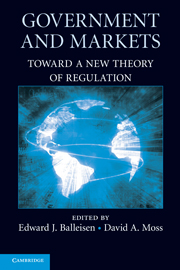Book contents
- Frontmatter
- Contents
- Acknowledgments
- Contributors
- Introduction
- SECTION I BEYOND MARKET FAILURE
- SECTION II BEYOND THE ECONOMIC THEORY OF POLITICS
- 6 The End of Special Interests Theory and the Beginning of a More Positive View of Democratic Politics
- 7 Public Choice: A Critical Reassessment
- 8 The Paranoid Style in the Study of American Politics
- 9 Law, Policy, and Cooperation
- SECTION III BEYOND COMMAND AND CONTROL
- Conclusion
- Index
- References
8 - The Paranoid Style in the Study of American Politics
Published online by Cambridge University Press: 20 January 2010
- Frontmatter
- Contents
- Acknowledgments
- Contributors
- Introduction
- SECTION I BEYOND MARKET FAILURE
- SECTION II BEYOND THE ECONOMIC THEORY OF POLITICS
- 6 The End of Special Interests Theory and the Beginning of a More Positive View of Democratic Politics
- 7 Public Choice: A Critical Reassessment
- 8 The Paranoid Style in the Study of American Politics
- 9 Law, Policy, and Cooperation
- SECTION III BEYOND COMMAND AND CONTROL
- Conclusion
- Index
- References
Summary
What drives policymaking in a democracy? Is it our lawmakers' desire to serve the public interest or their desire to serve themselves through the accumulation of money, power, and votes? Most social scientists have long since concluded it is the latter – or, to put it another way, that the old public interest theory is dead. The central behavioral assumption of modern economic analysis, that individuals act in their own self-interest, has become the reigning behavioral assumption of modern political analysis as well.
Partly as a result, a large subset of social scientists – perhaps the vast majority in some fields – has come to assume that special interest groups dominate, or capture, the policymaking process by satisfying the policymakers' need for money and other forms of political support. “The preferences of the ‘majority,’” writes Jonathan Macey, “are virtually irrelevant in determining legislative outcomes. Instead, law is made by legislators whose primary goal is to aggregate the political support they receive from competing special interest coalitions. Legal rules are generated by a process that conforms to standard microeconomic models of rationally self-interested behaviour.”
What makes this economic theory of regulation at once so powerful and so peculiar is its portrayal of representative democracy as profoundly unrepresentative – a tool of organized minority interests rather than of the majority interest. To arrive at this result, it is not enough to assume that lawmakers behave as rationally self-interested actors.
- Type
- Chapter
- Information
- Government and MarketsToward a New Theory of Regulation, pp. 256 - 298Publisher: Cambridge University PressPrint publication year: 2009
References
- 1
- Cited by



